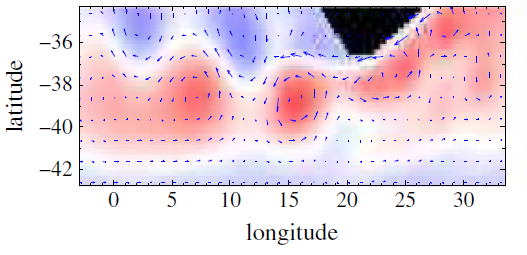Agulhas Leakage
The Agulhas Current is the strong western boundary current of the South Indian Ocean. It flows southward along the east coast of southern Africa, but when it passes the southern tip of South Africa, it makes a tight turn (retroflects) and flows back into the Indian Ocean. However, this retroflection short-circuits every few months spawning a large column of warm and salty Indian Ocean water that drifts into the Atlantic. This process is called Agulhas Leakage (De Ruijter et al. 1999).

Studies using both conceptual 2D models (Weijer et al. 1999; Weijer et al. 2001) and a low-resolution GCM (Weijer et al. 2002) indicate that the interocean fluxes of heat and salt may exert a considerable influence on the strength and stability of the Atlantic Meridional Overturning Circulation (AMOC). In the case of Agulhas Leakage, the salt and temperature anomalies initially cancel with respect to density. Rapid decay of the thermal anomaly leaves a density anomaly when the Indian Ocean water is advected northward. This results in a modification of the large-scale pressure distribution that tends to strengthen the overturning circulation. And since a stronger overturning circulation enhances advective feedbacks, it also becomes more stable with respect to large-amplitude perturbations. This work was my PhD research under supervision of Will de Ruijter, in collaboration with Henk Dijkstra and Peter Jan van Leeuwen, at IMAU (Weijer 2000).

In Weijer et al. 2013, we studied Agulhas Ring formation in a simple shallow-water model of the South Indian/South Atlantic Ocean wind-driven circulation. We performed a normal mode analysis and found that the dominant (destabilizing) mode showed clear resemblance to the ring formation process. We interpreted this mode as a barotropic instability of the shear zone between the Agulhas Current and Agulhas Return Current.
In two other papers, we studied Agulhas Leakage and its impact on the AMOC in a state-of-the-art coupled climate model, the CCSM4 (Weijer et al. 2012; Weijer and van Sebille 2014). In this model we found no significant impact of decadal variability in Agulhas Leakage on the strength of the AMOC. We conclude that the resolution of the model is too low to properly represent the process of Agulhas Retroflection and ring shedding. In fact, the actual interocean exchange is too strong, as predicted by viscous theory. As a result of this too strong coupling, the contrast in water mass properties between the southwest South Indian and southeast South Atlantic Oceans is reduced compared to observations. As a consequence, variability in the volume exchange hardly affects the stratification in the South Atlantic, which is the main mechanism of remote impact on the AMOC.
References
- de Ruijter et al. 1999: Indian-Atlantic inter-ocean exchange: Dynamics, estimation and impact. J. Geophys. Res., 104, 20885-20910, doi: 10.1029/1998jc900099.
- Weijer and van Sebille, 2014: Impact of Agulhas Leakage on the Atlantic overturning circulation in the CCSM4. J. Clim., 27, 101-110, doi: 10.1175/jcli-d-12-00714.1.
- Weijer et al. 1999: Impact of interbasin exchange on the Atlantic overturning circulation. J. Phys. Oceanogr., 29, 2266-2284, doi: 10.1175/1520-0485(1999)029<2266:ioieot>2.0.co;2.
- Weijer et al. 2001: Stability of the Atlantic overturning circulation: Competition between Bering Strait freshwater flux and Agulhas heat and salt sources. J. Phys. Oceanogr., 31, 2385-2402, doi: 10.1175/1520-0485(2001)031<2385:sotaoc>2.0.co;2.
- Weijer et al. 2002: Response of the Atlantic overturning circulation to South Atlantic sources of buoyancy. Glob. Planet. Change, 34, 293-311, doi: 10.1016/s0921-8181(02)00121-2.
- Weijer et al. 2012: The Southern Ocean and its Climate in CCSM4. J. Clim., 25, 2652-2675, doi: 10.1175/jcli-d-11-00302.1.
- Weijer et al. 2013: Agulhas ring formation as a barotropic instability of the retroflection. Geophys. Res. Lett., 40, 5435-5438, doi:10.1002/2013GL057751.


